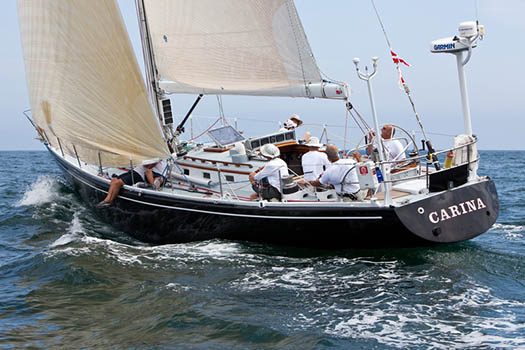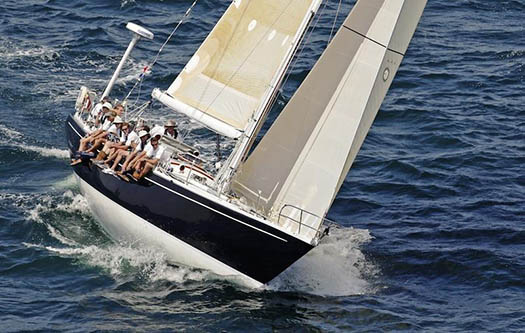#rys – Visiting boats have dominated the Royal Yacht Squadron's historic Bicentenary Regatta in the Solent this past week writes W M Nixon. In a series which was has experienced all four season and almost every level of wind strength – sometimes in just one day - it was former Admiral of the Royal Cork YC Anthony O'Leary with his Munster red Ker 40 Antix who raced through to become overall winner of Class 1A, while current New York Yacht Club Commodore Rives Potts won Class 3 in his veteran Jim McCurdy-designed 48ft aluminium sloop Carina.
To describe Carina as "veteran" scarcely does her justice. Her design concept first emerged in 1968 as successful father-and son offshore racing duo Dick and Richard B Nye of New York brainstormed with designer Jim McCurdy (whose family may well have emigrated to America from Ireland's Rathlin Island a very long time ago) to produce a 48 footer which would successfully anticipate the planned International Offshore Rule.
Indeed, the Nyes – who had twice won the Fastnet with their 57ft Rhodes yawl, also called Carina, in the 1950s - hoped by example to encourage a healthy type of seaworthy yet fast boat for the new system. But as soon as the rule was in place in 1970, designers starting exploiting it to produce extreme boats with some unhealthy handling characteristics, while Carina soon found herself out-classed when adjustable trim tabs on the trailing edge of the keel – fundamental to her steady and successful performance – were banned by the IOR.
Her successful placings steadily declined. But instead of getting a new boat, in 1978 the Nyes went into conference with Australian-born New York-based designer Ted Kauffmann, who came up with radical drawings which gave Carina a completely new fin keel of the type developed by Doug Peterson and Ron Holland, while her original wide barn door of a skeg-hung rudder was replaced with a deep spade rudder which had a perfect endplate effect where it fitted closely under the hull, regardless of the angle it might be at.
All this initially involved considerable skilled and very dusty modification work with angle-grinders through aluminium in Bob Derecktor's famous yard in Marmaronek, and the young trainee worker who was right in the thick of the dustiest stage was Rives Potts, who was ultimately to buy Carina himself in 2007.

The all-conquering 48ft Carina (Rives Potts, NYYC). With much TLC and useful mods such as a more effective keel and rudder, and a carbon mast, the 1968-designed Carina has been kept competitive. Note how she achieves style with economy. There's no expensive varnished toe-rail to maintain – it's just a white-painted aluminium strip – but the little bit of wood brightwork on the coachroof and around the cockpit is immaculately maintained for maximum effect. Photo courtesy CCA

Carina well on the way to her first great win under Rives Potts' ownership, first overall in the 2010 Newport-Bermuda Race. Photo courtesy CCA
By 2008 he was starting to become competitive with her, and soon had the overall win in the Newport-Bermuda Race in race logged in June 2010. He then took part in the August 2011 Fastnet and won his class in that, so some junior members of the crew sailed the boat to Sydney to take part in the December 2011 Rolex Sydney-Hobart Race – in which they were a respectable 21st overall – and then they sailed on home westward against the prevailing winds across the southern Indian Ocean to be back in Newport in time for the 2012 Bermuda Race, which they duly won overall again.
Carina is still in the hunt, as during the RYS Bicentenary she won the race round the Isle of Wight, particularly sweet for a NYYC Commodore who is the linear descendant of those who won a similar race in 1851 to begin the America's Cup saga. But in the end, it all hung on yesterday's race, when the Solent was plagued by calms and flukey zephyrs. Only one boat managed to finish within the time limit in Class 3, Carina's class. But that was Carina herself, demonstrating the well-designed heavy displacement boat's uncanny ability to keep going in calms to glide on across glassy water from one little puff of wind to another, provided that her crew have managed to get her up to speed in the first place. It was a fairytale ending to the latest chapter in one of world sailing's great stories, a litany of success which has now been going on for 47 years.

Carina giving a forceful impression of her steady power, thrusting to windward in the Tasman Sea during the 2011 Rolex Sydney-Hobart Race. Yet thanks to her considerable weight, she can be a remarkably good performer in calms, for once speed has built up, she can carry her way to glide across calm patches to the next tiny puff of breeze. Photo: Rolex/Daniel Forster
































































